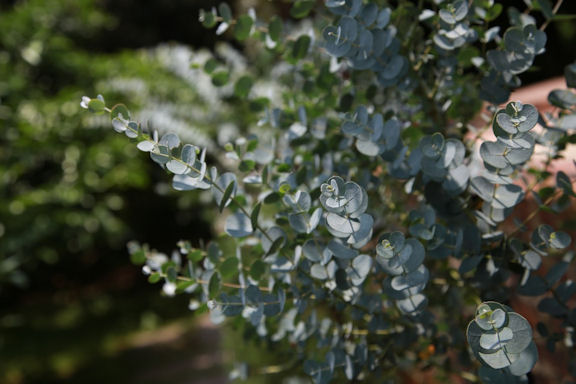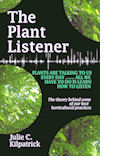Eucalyptus
It's evergreen, it looks good, smells great, loves to be pruned and it's extremely useful. What more could you ask for in an ornamental tree or shrub?
It's one of those plants that immediately draws the eye. Even from a distance, the silver-blue leaves stand out. Get up close to it and you can see why eucalyptus is such a good all-rounder. Depending on the variety and maturity of the tree, the bark is either grey and silver, flaking, creamy-white, pinkish-grey, patchwork or snakeskin but never plain old brown. Reach up and crush one of the leaves and you get that distinctive scent that reminds you of Vicks Vaporub and the last time you had a cold.
Most evergreen trees are well...just green...but here's a tree that gives you colour all year round. And what colour it is! As well as the silvery leaves and the gorgeous bark, many varieties will give you young red stems and this red and silver combination is, from a design point of view, very striking. You can really show of your eucalyptus by planting it near a red-leaved shrub. If you have space for an avenue of trees, plant eucalyptus with Acer 'Crimson King'. Even if you don't have the space, grow Acer palmatum 'Bloodgood' or Cotinus 'Royal Purple' nearby.

Eucalyptus, at maturity, is a tall tree with an eventual height of between 10m and 20m but it responds well to pruning and you can keep it at a reasonable height by cutting it back as hard as you like every so many years.
Pruning eucalyptus also gives you the added bonus of retaining the young, rounded foliage that is so popular with flower arrangers. (Mature leaves are long and narrow). With careful pruning, you can even grow eucalyptus as a hedge.
Eucalyptus oil has anti-viral and anti-bacterial properties and is used in the treatment of coughs, flu, cattarh and sinusitis. It eases muscular aches and pains and is reputed to be a flea and insect repellant.
As a garden designer, I use eucalyptus whenever I can because, quite simply, it has the wow factor. You don't see it all that often in the west of Scotland, where I live, but when you do you can guarantee it'll be talked about. Where there's one growing nearby, my clients will invariably point to it and say, "I want one of those".
In its native country and in tropical climates, Eucalyptus grows in forests and produces petal-less flowers consisting of many white, yellow or red stamens.

However, in the UK it is unlikely to flower and it's not a tree you can grow just anywhere. It doesn't like exposed sites and strong, cold winds turn the leaves brown, eventually killing it. It likes to be in full sun and detests it if its feet are water-logged. It is often recommended for planting on coastal sites because, like most silver-leaved plants, it is tolerant of salt-laden air but only plant it in your seaside garden if you can give it some protection from strong winds. Some varieties are not frost-hardy so check the label before you buy.
You won't often see a mature specimen for sale at nurseries because, where eucalyptus is concerned, the smaller the better when it comes to planting it. It needs time to settle in and you'll get a much better success rate if you plant it small.
Julie Kilpatrick is editor of Gardenzine and author of The Plant Listener.









